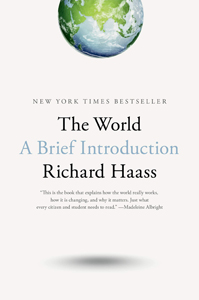 Richard Haass, The World: A Brief Introduction (New York: Penguin, 2020), 378pp.
Richard Haass, The World: A Brief Introduction (New York: Penguin, 2020), 378pp.
For almost forty years, Richard Haass has distinguished himself as one of America's foreign policy experts. He earned his PhD at Oxford and has authored or edited fifteen books. He's advised administrations in both parties. Since 2003 he has been president of the non-partisan Council on Foreign Relations. In a previous book called Foreign Policy Begins at Home (2013), he argued that the biggest threats to America are domestic rather than international. We're overreaching and underperforming, and need to focus on reforming ourselves rather than remaking other countries.
Haass's newest book widens his lens in order to examine the entire world, albeit at a generalized level. It's like a good seminar 101 whose goal is increased global literacy. And global literacy among our citizenry is in short supply, by his reckoning. That's unfortunate, particularly because the so-called "Vegas Rule" that what happens there stays there "does not apply in today's global world." Like it or not, globalization is not so much a theory as it is a brutal reality. Haass's book is divided into four sections.
Part one explores the history of the modern world and the rise of nation states that began in the seventeenth century. Successive chapters review the years 1914 through 1945 ("the deadliest years in all of history"), the Cold War era that avoided violent conflict, then the period that followed with the fall of the Berlin Wall in 1989. Part two reviews the six major regions of the world: Europe, East Asia and the Pacific, South Asia, The Middle East, Africa, and the Americas. Part three examines nine important challenges in our globalized world, issues like terrorism, climate change, nuclear proliferation, etc. Part four explores the idea of world order ("the most basic concept of international relations"), as opposed to chaos and violence, and the things that make for stability, like alliances, treaties, and the concept of sovereignty.
Haass has sacrificed depth for breadth in this book, but that's just fine, given his expertise. The book is a brisk read. For example, Part Two gives you 15-page overviews of the six geographic regions of the world. Likewise for Part Three, where you get 10-page chapters on nine important issues. The book concludes with seventy pages of "where to go for more" that suggest books, articles, websites, etc. for a deeper understanding of our globalized world.
Dan Clendenin: dan@journeywithjesus.net


